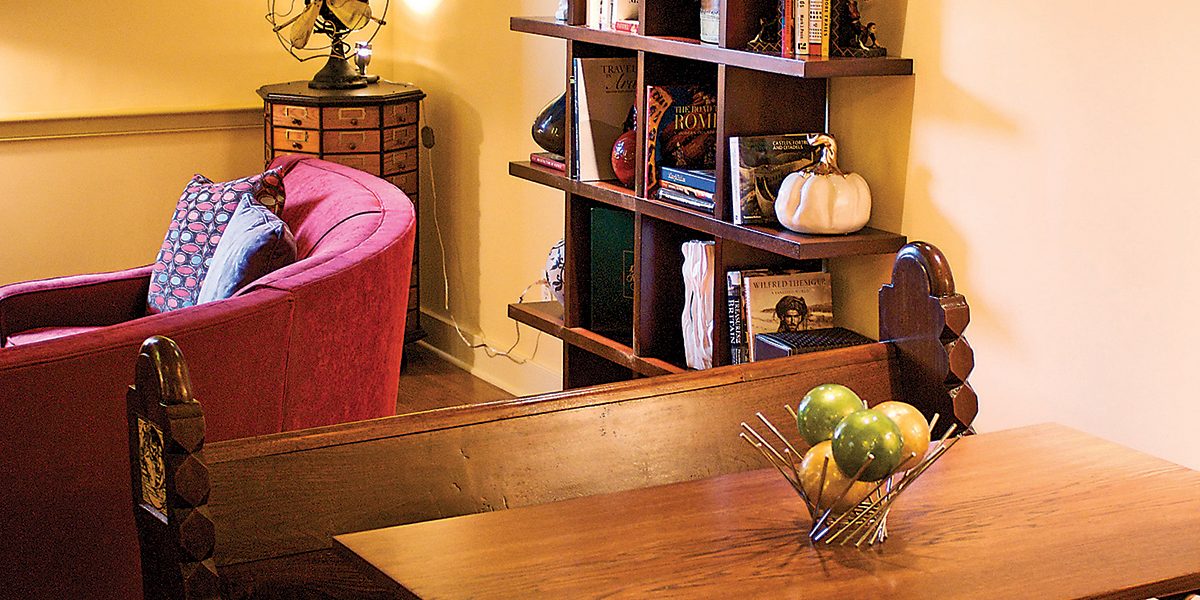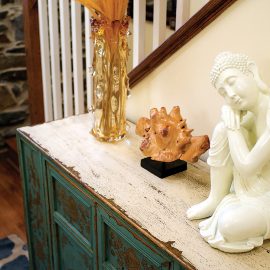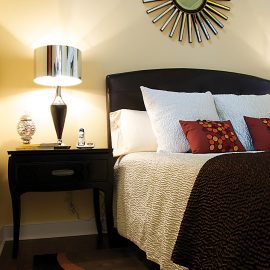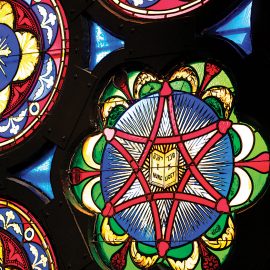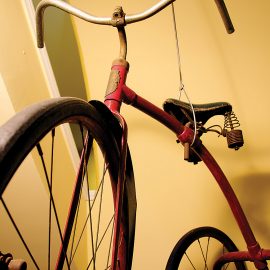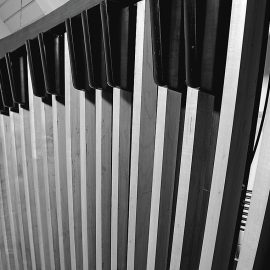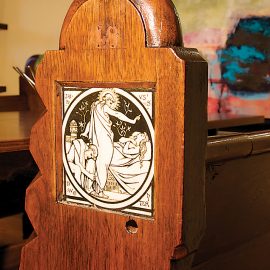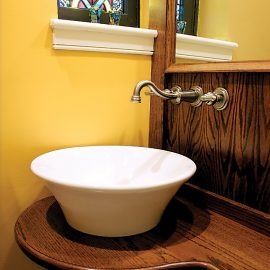Arts & Culture
Marin's Sacred Space
The BSO maestra's new digs give her divine inspiration.
After living for nearly two years in a corporate rental apartment,
BSO Music Director Marin Alsop wanted a place that felt like home.
“I wanted to have my own space,” says Alsop, who also shares a house
in Denver with her partner Kristen Jurkscheit and their five-year-old
son Auden. “I started looking at a lot of high rises with a Realtor, and
one day I finally said to her, ‘I’m so sorry. I hope you don’t think
I’ve wasted your time, but I lived in a high rise in Manhattan, and it’s
just not what I want.’ I said, ‘I’d love to live in a church or
someplace with real character.'”
Cue the angels singing. Because on the way back from her meeting with
the Realtor, Alsop noticed a “For Sale” sign hanging on a Mt.
Vernon-area historic church. The building had been converted into four
condominiums. She decided to see what was available. Though she was
first shown another condominium toward the back of the space, Alsop went
wild for the front condo with its majestic, multi-paneled, 12-foot
stained glass windows. The space was being rented at the time, but Alsop
knew it had to be hers. “Even before I had seen the inside,” she
recalls, “I knew I wanted to buy it. When I had said I wanted to live in
a church, it was like in my dreams, and here I was.”
The renters moved out and, by November 2008, Alsop had purchased her
dream home. Now she was faced with the daunting prospect of decorating
it. (After all, what’s the point of having a dream house if it doesn’t
have a dream interior?) She turned to Steve Appel, co-owner of Belvedere
Square’s Nouveau Contemporary Goods and senior designer of Whitehead
& Appel Interior Design. Alsop and Appel had worked together in
2007, when he transformed her dressing room from fusty to fabulous with
the addition of hardwood floors, grass cloth walls, and hip, retro-chic
furnishings.
“When I was thinking about trying to decorate a place, I had never
used an interior designer—that always seemed like something you do for a
hunting lodge,” says Alsop. “But Steve’s attention to detail was so
formidable, I called him when I was looking, and I said, ‘Steve, I don’t
know where I’m going to end up, but I’d like to talk to you about
designing whatever space I get,’ and then when I found this, and I
brought him over, he totally flipped.”
While the busy maestra was jaunting between London, Los Angeles,
Stockholm, and Spain, Appel began customizing the two bedroom,
two-and-a-half-bath space. His challenge? To hit a pitch-perfect
decorating note in time for Alsop’s Baltimore homecoming in February
2009.
“It needed to fit her like a glove,” says Appel. “It needed to have
areas where she could relax and write scores, listen to music, and spend
time with her son. She also needed a very sophisticated area to
entertain BSO patrons. These were her directives. I tried to bring out
the ideas that were deep inside of her that she couldn’t express in this
sort of venue. She could express it in music, but not in interior
design.”
When Appel first stepped into the space, he had a vision of incorporating elements of the church into the design.
Luckily, thanks to the foresight of builders Louren Roddick and
Jerome LeBlond, such items had been painstakingly saved and restored. As
a result, Alsop’s home is now filled with unique liturgical relics,
including pipe organ pedals artfully suspended on a wall in a sitting
room, original church pews with inset Minton tiles that stand in as
dining room seating, and a massive circa-1900 amber colored converted
gas lantern, once hung over the main altar, that now illuminates the
dining room table.
“Some guys might pick up a hammer and start swinging,” explains
LeBlond of saving parts of the original church. “That’s what we didn’t
want to do.”
An added decorating bonus: Alsop’s parents, both professional
musicians, are also inveterate collectors. “Whenever I move somewhere,
my parents love to come with a big truck and unload a lot of their
antiques like the three-legged tables,” chuckles Alsop. “They’ll say,
‘Oh, this only needs a little work.’ I wanted to bring in their love of
old things because I love old things, too, but I still wanted a place
that was livable and hip and cozy and comfortable.”
Appel offered to view her father’s collection. After an arduous,
nine-hour, snowy drive to her parent’s property in Saratoga Springs, NY,
he found himself rummaging through two barns and a basement filled with
a lifetime’s worth of antiques and bric-a-brac.
“Her dad is an obsessive collector,” notes Appel. “Antiques Roadshow could be filmed at his house.”
Recalls Alsop: “Steve was running around while he was on the phone
with me saying, ‘Okay, I like that tricycle,’ and I’m thinking,
‘Tricycle? What are you going to do with a tricycle?'”
Among Appel’s finds that are now placed throughout the maestra’s
home: a wooden scooter from the late 1800s, intricate blue and pink Art
Nouveau panels of stained glass, a 1920s black fan with brass blades, a
dark walnut Empire-style mirror, an antique manjo (a cross between a
mandolin and a banjo), an RCA Victrola, and, of course, that red 1920s
tricycle, which is now prominently suspended in an alcove between the
sitting and living rooms.
Alsop’s own sense of beauty was nurtured through exposure to many
forms of art. When she wasn’t learning to play the piano (age 2) or
taking on the violin (age 5), she helped her parents rehab several
fixer-uppers, including a modest two-bedroom home in Westchester, NY,
where Alsop’s father, Llamar, built a 40-foot cathedral ceiling room for
chamber music. “We had this tiny little house with one bathroom, and
this huge living room for chamber music,” says Alsop with a laugh.
As Alsop grew older, her father purchased the house in Saratoga
Springs, NY, a converted Victorian-era nursing home that, at the time,
was quite ramshackle.
“I spent my formative years peeling paint off that house,” says
Alsop. Although the house itself needed extensive work, Alsop’s
father—always a bit of a dreamer—decided it was a priority to build an
addition, a concert hall that seated up to 150 people. “My father loves
architecture and has always fancied himself a bit of a designer,” she
says.
Alsop’s father even smuggled in a bit of rare contraband to finish
the space. “They used to have these beautiful wooden beams for light
poles on the West Side Highway,” she says. “When my dad heard they were
taking them down, he wanted to put those in the concert hall. He did
some deal with one of the workers and picked them up in the middle of
the night, but because we didn’t have a babysitter, my parents woke me
up, and off we all went to the highway. We spent our free time on these
crazy projects.”
Her parents’ anything-goes approach to objects, art, and
architecture, made an impact on their only child. “I’m an odd amalgam—I
appreciate and have a fairly decent eye for old things, but I also love
simplicity and clarity and non-clutter,” Alsop says. “I’m a mix of
really simple taste and over-the-top taste at the same time. I think it
is reflected in this place. I want to respect tradition but do the
unexpected, too, and do it in an air of comfort not to put people off.”
Those very words could describe Alsop’s approach to conducting. After
only two seasons, Alsop has made her mark on the BSO, which just signed
her to a five-year extension. She has been lauded for making classical
music accessible and affordable to all, lowering ticket prices, and
designing innovative educational programs for school children.
“The [condo] is a fantastic blend of antique and contemporary, much
like Marin’s programming at the BSO,” says Alsop’s former executive
assistant, Jeffrey Luther. “She often pairs a contemporary piece of
music with a classic piece, putting the older piece in a new context and
highlighting the inspiration behind the new piece.”
Alsop enjoys the same sense of the unexpected in her adopted hometown.
“It’s a little quirky,” Alsop says of Baltimore. “It’s the perfect
combination of east coast city but has a really nice, warm, small town
feel to it as well. I find it interesting and curious and different, and
the people are so nice. People are always asking, ‘How can I help with
the Symphony? How can I help with the outreach programs you are doing?’
[That’s] not usually the first question people ask completely
unsolicited.”
As Alsop gets ready to launch the BSO’s 2009-10 season (beginning
September 12), she credits her new space with helping to inspire her.
“I started thinking about how we all share an innate understanding of
music and art,” explains Alsop. “This season is really a celebration of
our shared musical roots and to have this space to come to and reflect,
I find really healing and inspiring. Living here, I feel a little bit
like I’m in the eye of the storm where everything is going on around me,
but my place is very calm. When I’m on the road and in hotels, there is
a lot of trying to cope with existing. Finally, having a space that is
aesthetically pleasing and emotionally rewarding feels great.”
